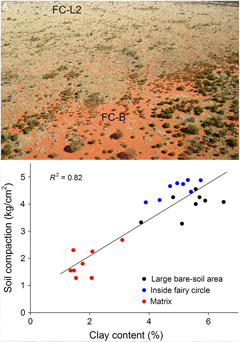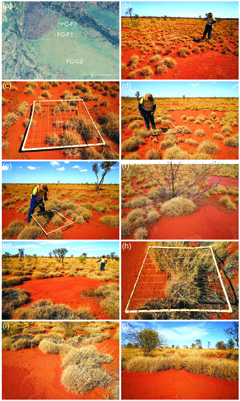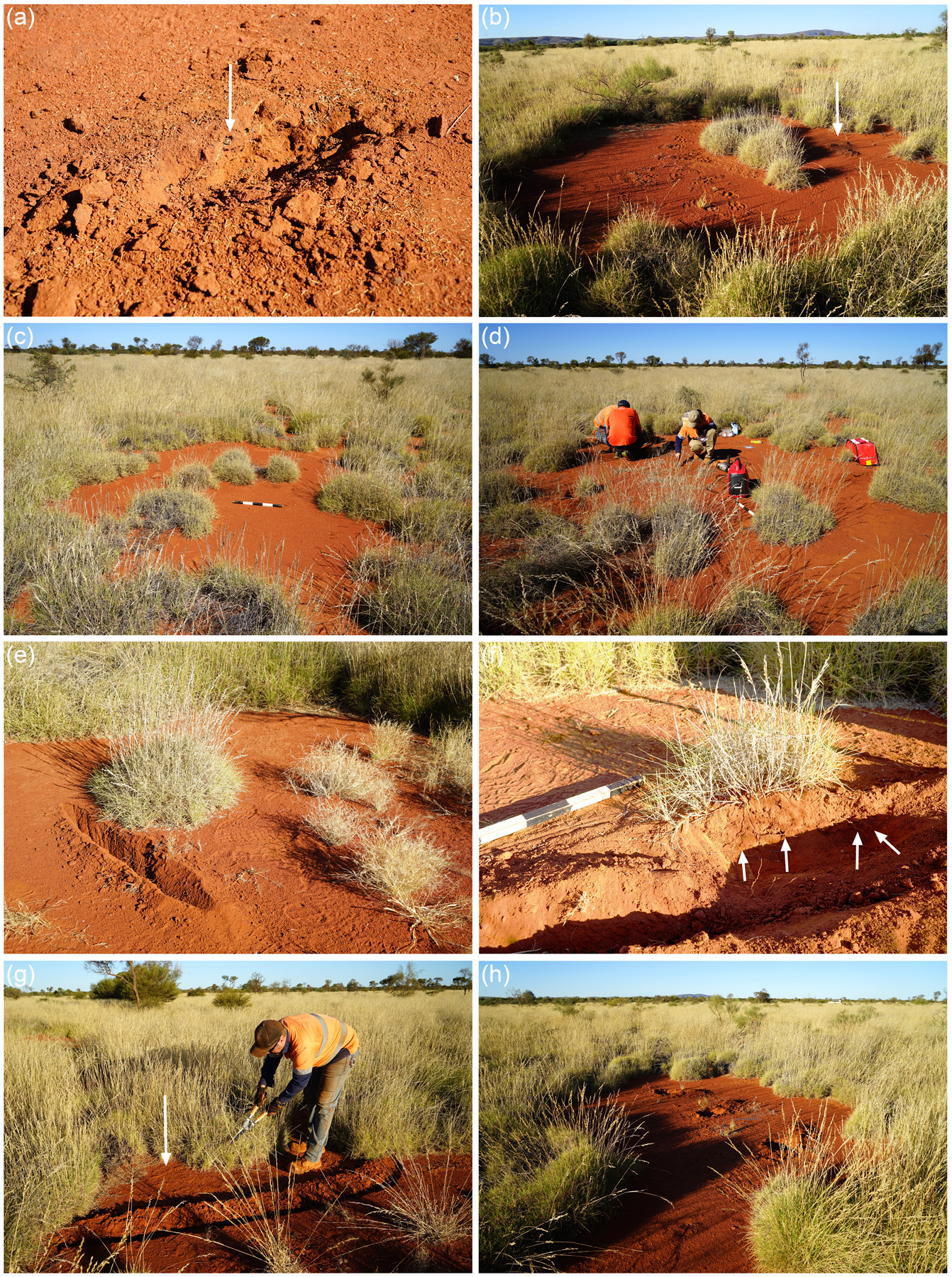Dr. Stephan Getzin | Scientist | Ecologist
Australian fairy circles are caused by abiotic weathering and biomass-water feedbacks
Fairy circles are a unique and globally rare phenomenon because, unlike other common vegetation gaps that are widespread worldwide, fairy circles have specific characteristics that distinguish them from the latter. One of the defining characteristics is their ability to form spatially periodic patterns that are significantly more ordered than an “ordinary” regular pattern. From the 1970s until the year 2014, such fairy circles were only known from the Namib Desert in southwestern Africa. However, when Australian environmentalist Bronwyn Bell sent me aerial photos of similar-looking fairy circles near the town of Newman in the Pilbara region of Western Australia, we immediately flew there and thoroughly investigated these vegetation gaps on site in December 2014. Spatial analysis of the grassland gaps revealed indeed identical spatially periodic patterns, as are known from the fairy circles of Namibia. The circles are also very large with diameters ranging up to 7 m. We then started digging in the fairy circles and noted that the plants could principally grow at virtually any location within the large gaps – just as Namibian fairy circles can also revegetate with grass for some time after rainfall. We noted that harvester termite nests can locally be abundant in that area but their hard pavements – if present in a circle – occurred at the edge of the circle and their surface crusts restricted plant growth only in their immediate vicinity of 1 m but not further. Also, termite-nest patterns occurring in the same area like fairy circles did not match the patterns of the circles, hence there was no relation between the two types of patterns. Chemical analysis with high resolution electron microscopy revealed that the mechanical crusts found in the gaps were only the result of mechanical weathering and the impact of rainfall drops and not the remnants of eroded termite mounds. The mechanical soil crusts form during heavy rainfall events due to particle dispersion of the sand at the surface, which seals the sand pores and causes water-impermeable clay crusts. Additionally, we measured soil surface temperatures within the circles at noon that reached as much as 75°C, causing literally a baking of the soil surface after rainfall. All this was published in 2016 as the Discovery of fairy circles in Australia.
 Between 2017 and 2019, we investigated the Australian fairy circles for three years even more in detail. This collaboration with Todd Erickson from Kings Park and Botanic Garden and The University of Western Australia focused again specifically on the mechanisms that cause the circles. Together with other colleagues from Australia and Israel we showed, for example, that the plant-inhibiting mechanical soil crusts within the circles have the same clay content and soil hardness as the large bare-soil areas that border next to fairy circles, and where grass is absent for hundreds of meters. Of course, these large bare-soil areas cannot be explained by termite pavements because these occur only very locally. Our study also showed that cemented termite pavements were largely absent from 154 excavated holes within the fairy circles and we emphasized in our 2019 Ecosphere paper that “partial correlation with aboveground or underground termite (or ant) signs does not imply causation and that such mere correlation needs to be carefully interpreted”. The same paper demonstrates also that common termite gaps in Western Australia are significantly less ordered and with diameters of only 2.2 to 2.5 m, the termite gaps are significantly smaller than fairy circles. Hence, Drepanotermes harvester termites cannot explain the observed structure of the fairy circles.
Between 2017 and 2019, we investigated the Australian fairy circles for three years even more in detail. This collaboration with Todd Erickson from Kings Park and Botanic Garden and The University of Western Australia focused again specifically on the mechanisms that cause the circles. Together with other colleagues from Australia and Israel we showed, for example, that the plant-inhibiting mechanical soil crusts within the circles have the same clay content and soil hardness as the large bare-soil areas that border next to fairy circles, and where grass is absent for hundreds of meters. Of course, these large bare-soil areas cannot be explained by termite pavements because these occur only very locally. Our study also showed that cemented termite pavements were largely absent from 154 excavated holes within the fairy circles and we emphasized in our 2019 Ecosphere paper that “partial correlation with aboveground or underground termite (or ant) signs does not imply causation and that such mere correlation needs to be carefully interpreted”. The same paper demonstrates also that common termite gaps in Western Australia are significantly less ordered and with diameters of only 2.2 to 2.5 m, the termite gaps are significantly smaller than fairy circles. Hence, Drepanotermes harvester termites cannot explain the observed structure of the fairy circles.
 In another article published in the Journal of Ecology 2021 we showed in detail with soil-moisture sensors how rainfall impact in the summer months induces the soil crusts within fairy circles. We also show how the Triodia grasses form more and more closed barriers over time after a destructive fire in order to optimize water harvesting (left image). This plasticity in the growth behavior of the Triodia grass is the same type of “ecosystem engineering” that is exerted by the various grass species in Namibia that form large fairy circles or smaller plant rings along the Namib. Another study published in Landscape Ecology 2022 revealed that at all sites with Australian fairy circles, small vegetation gaps emerged consistently at a distance of 5 m away from the large circles. These are the distances where the vegetation is furthest away from the water source of the fairy circles, hence the bare soil reflects the severe water stress for the plants in this arid ecosystem.
In another article published in the Journal of Ecology 2021 we showed in detail with soil-moisture sensors how rainfall impact in the summer months induces the soil crusts within fairy circles. We also show how the Triodia grasses form more and more closed barriers over time after a destructive fire in order to optimize water harvesting (left image). This plasticity in the growth behavior of the Triodia grass is the same type of “ecosystem engineering” that is exerted by the various grass species in Namibia that form large fairy circles or smaller plant rings along the Namib. Another study published in Landscape Ecology 2022 revealed that at all sites with Australian fairy circles, small vegetation gaps emerged consistently at a distance of 5 m away from the large circles. These are the distances where the vegetation is furthest away from the water source of the fairy circles, hence the bare soil reflects the severe water stress for the plants in this arid ecosystem.
All this intensive research undertaken during different seasons over several years between 2014 and 2019 revealed the actual mechanism that causes the Australian fairy circles. Then, authors around the ethnobotanist of Walsh et al. published an article in Nature Ecology & Evolution 2023 with the title “First Peoples’ knowledge leads scientists to reveal ‘fairy circles’ and termite linyji are linked in Australia”. In this article, the authors emphasized a correlation between fairy circles and termite pavements (linyji) to generalize that all common termite gaps, which are very abundant in the interior of Australia, and fairy circles would be the same. This, however, is not the case because the common termite linyji they address are much smaller and less ordered than true fairy circles, and these abundant vegetation gaps are clearly caused by termite pavements. Their fieldwork near Newman, which was undertaken within one week in July 2021, centers around the presence of termite nests but it does not address the actual plant-inhibiting mechanism that is responsible for the vegetation gaps, especially in the absence of termite pavements. The authors present beautiful cultural paintings in their paper but they do not show any data analysis of soil crusts such as on the chemical composition, clay content, soil hardness or water infiltrability. We have responded with our new Nature paper to them and emphasize with the title “Australian fairy circles and termite linyji are not caused by the same mechanism” that only the causal mechanism matters but not a mere correlation with termites. According to previous work of Walsh et al., termite “pavements are very hard, withstanding fire, flood, and road grader blades” and “inhibit plant growth due to their hardness and resistance to surface water infiltration”. According to them, “pavements are flat and cemented” and “termite chambers occurred within 5 cm of the surface”. We fully agree with this definition of termite pavements, and in our papers we have shown such pavements with photo documentation. Such cemented pavements are indeed very hard but easily identifiable by using a hammer. In 2016 PNAS we wrote, for example, “In those few cases when the thick mechanical soil crusts resulting from weathering could not be visually distinguished from the thick caps of pavement-like mounds, the crusts were opened with a hammer to verify the presence of termite galleries or holes below the hardened soil crusts.” In our 2019 Ecosphere article we wrote with regard to these termite linyji “The rock hard soil surface is easily recognized even by simple hammering with a wooden stick on the gap surface. The termite chambers have a characteristic hollow sound which reflect the termite-nest structure. When opened, all of these termite gaps showed within the first 5 cm termite galleries and termite chambers”. However, such termite linyji are absent from many fairy circles that we excavated in the area near Newman. The evidence for the absence of termite pavements was also provided by us with photographs such as can be seen in Figure 1 below. In addition, large parts of the fairy circles enable the growth of many grass individuals, as we have shown with counting statistics in our 2019 Ecosphere paper. We also show that grasses can develop roots and access soil water within the fairy circles because the sand is often relatively soft in the entire gap. This would not be possible if there would be termite pavements because such cemented termite crusts withstand even “road grader blades”.
In conclusion, our new paper in Nature Ecology & Evolution emphasizes that correlation and causation is not the same and that only the mechanism matters that induces the absence of the vegetation in the fairy circles. Our detailed fieldwork has demonstrated that the Australian fairy circles are caused by mechanical weathering of the soil surface in combination with biomass-water feedbacks of the plants. With this population-level response to water stress the Triodia grasses make the ecosystem more resilient in this harsh environment.
Figure 1. Example of a termite pavement under a layer of sand that we easily identified by a cemented structure and visible termite chambers, see arrow (a). A large fairy circle with a termite mound far on the right (arrow) but grass growth is not affected to the left of the mound (b). This cemented termite pavement has only a very local effect but the mechanism does not inhibit vegetation in the much larger circle. Fairy circles in the plot can have various amounts of grass because no pavements exist underneath the plants (c,d). Scale bar, 0.5 m. Pavements are neither found in the center of fairy circles (e,f), nor along 2 m long excavated trenches at the edges of the circles (g). The walls of the soils showed no termite chambers (as in a) but merely layers of compacted soil resulting from seasonally triggered rainfall, extreme heat, evaporation and erosion. Panel f shows a grass cut into halves. Many roots (arrows) grow deep in the sandy substrate because cemented pavements are absent. Typically, mechanical soil crusts form along the edges of virtually all fairy circles (arrow) where densely packed Triodia plants block the rain water from outflow (g). Excavations of a fairy circle in July 2017, revealing no termite pavements within the holes (h).Welcome to FAIRY-CIRCLES.info! I am interested in the ecology of drylands, fairy circles, plant rings and all kinds of spatial vegetation and animal patterns, using a whole range of quantitative methods.

